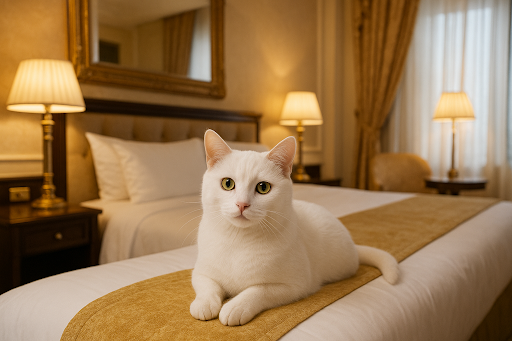Leaving your cat for the first time can tug at the heartstrings—especially if your whiskered companion prefers cosy couch corners over grand adventures. Whether you’re heading away for work or whisking yourself off on holiday, knowing your feline is safe, pampered, and cared for like royalty can make all the difference.
At Hotel for Cats, Sydney’s leading luxury cat boarding retreat, we’ve redefined what “boarding” means—offering your cat a five-star holiday that’s just as relaxing and indulgent as yours.
Why Choose a Luxury Cat Resort in Sydney?
When searching for cat boarding, cleanliness is a given—but true luxury lies in comfort, safety, enrichment, and personalised care. At Hotel for Cats, we blend all these elements into a tailor-made experience designed around your cat’s personality and needs.
From the moment they arrive, your feline is greeted with a calm, homely environment, soft bedding, and a team of attentive carers who treat them like family.
The Grand Suites Collection – Designer Luxury for Cats Who Deserve the Best
For cats who expect nothing short of purrfection, our Grand Suites Collection offers spacious designer suites crafted for peace, privacy, and pure indulgence.
Suite Highlights:
- Generous space (approx. 2m x 2m x 1.7m) with glass-fronted views
- Two plush memory foam beds for ultimate comfort
- Climbing shelves to spark curiosity and keep them active
- Cat exercise wheel in select suites or televisions for feline entertainment
- Regular playtime with our caring staff
- Photo updates sent directly to your phone
- Individually themed suites like The Boathouse, Safari, The Pavilion, Boho Pad, Clubhouse, and Loft
Please note: A 20% non-refundable deposit is required to secure your cat’s stay. Confirm your travel dates before booking.
Preparing Your Cat for Their First Stay
A little preparation goes a long way in ensuring a smooth transition for first-time guests.
- Keep Vaccinations Up to Date
Mandatory for all guests to ensure the health and safety of every cat. - Familiarise Them with Their Carrier
Place treats inside and leave it open at home for a few days before boarding. - Pack a Comfort Item
Bring a blanket, toy, or item that smells like home. - Stay Calm During Drop-Off
Cats pick up on your energy—stay relaxed and positive.
What Makes Hotel for Cats the Premier Choice?
With over 15 years of trusted experience, co-ownership by a vet, and a passionate team of carers, we offer a standard of care unmatched in Sydney.
Our Promise:
- Private luxury suites over three floors
- TVs, play zones, and climbing spaces for enrichment
- Onsite veterinary clinic for peace of mind
- Customised care plans based on temperament
- Flexible check-in (from 12 PM) and check-out (by 11 AM)
Designed for Every Cat Personality
Whether your cat is a playful kitten, a curious explorer, or a serene senior, we have the perfect suite for them. From the Penthouse to the Grand Suites, every guest enjoys:
- Calm, spacious surroundings
- Thoughtfully designed furniture
- Human interaction when they want it
- Quiet privacy when they don’t
Book Your Cat’s Luxury Getaway
Give your cat the pampering they deserve while you’re away. At the Hotel for Cats, every whisker, paw, and purr matters. Whether it’s their first stay or a return visit, they’ll be treated like the royalty they are.
Reserve your cat’s suite online today and let them enjoy a stay as luxurious as your own holiday.

